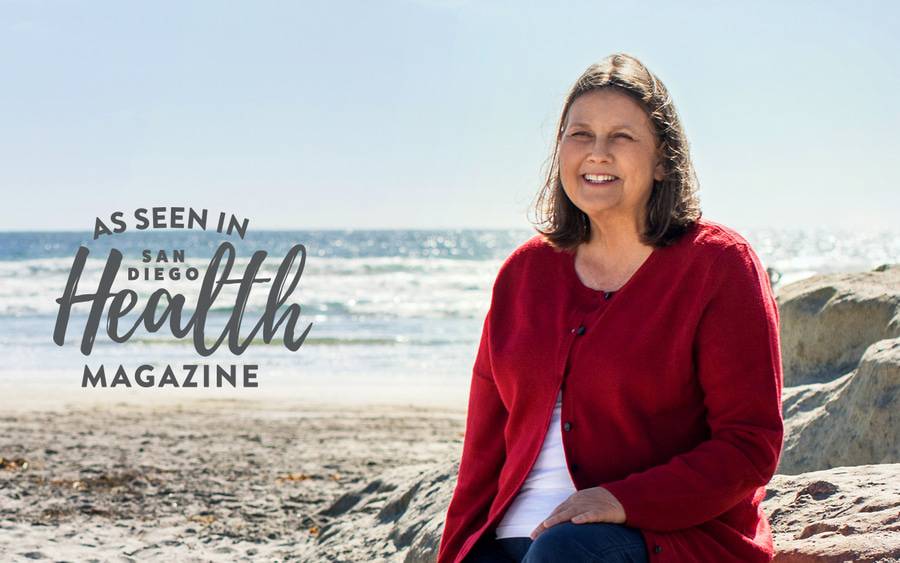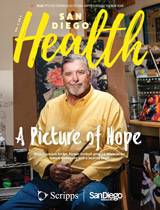Patient Has Rare Mitral Valve Procedure
Cancer survivor has life-saving heart procedure for mitral stenosis

Cancer survivor has life-saving heart procedure for mitral stenosis
If you look up the word “survivor” in the dictionary, you’re likely to find a picture of Kim Trauth.
In October 1982, at age 14, she was diagnosed with late stage non-Hodgkin’s lymphoma and was not expected to live through December. Her doctors did what they could, attacking the cancer with chemotherapy and radiation. Miraculously, her lymphoma was in remission by Christmas.
But the radiation treatments took their toll on Trauth’s heart. At the time, patients received higher, less targeted doses of radiation than they do today, which damaged her heart. While her life was mostly normal through college and her 20s, heart problems started cropping up a decade later.
After childhood cancer treatment, an aortic valve replacement
In 2006, Scripps cardiothoracic surgeon John Tyner, MD, replaced Trauth’s aortic valve.
“Because of her radiation for lymphoma, it was a complicated case,” says Dr. Tyner. “After radiation to the chest, everything gets fibrosed [scarred]. Wound healing and surgical access are difficult. The radiation saved her life, but it destroyed her valve. We put in a mechanical valve, hoping we’d never have to go back again.”
Trauth recovered well from her surgery, but the damage wasn’t limited to her aortic valve. Her mitral valve, which helps control blood flow from the lungs to the heart, was also degenerating. The decline was slow but steady. She noticed simple tasks were becoming quite difficult.
“I’d go to the grocery store, and it would just take longer,” Trauth says. “I’d lose my breath easier. I’m really getting out of shape, I thought, not realizing it was my heart.”
The next challenge: mitral valve stenosis
Trauth’s fatigue was caused by calcium and scar tissue building up on her mitral valve. As a result, her body was having great difficulty moving blood from her lungs to the left ventricle, the heart’s main pumping chamber.
“Because of her radiation, the valve had become calcified and poorly mobile,” says Dr. Tyner. “It had narrowed considerably.”
Trauth’s narrowed valve was also causing problems elsewhere in her body. As it became more difficult for oxygenated blood to get through her heart, pressure started building up in her lungs, causing congestive heart failure, fluid in the lungs, difficulty breathing, leg swelling and other issues.
This type of mitral valve degeneration often accompanies aging, but Trauth’s radiation treatments had accelerated the process. Chronologically, she was in her 50s, but her heart appeared much older.
The malfunctioning valve reduced the oxygenated blood Trauth needed to energize her body. She became reliant on portable oxygen tanks — first only at night, then all day long. She could leave the house only for limited periods, as the tanks only deploy oxygen in pulses, rather than a steady stream. She could no longer take her teenage daughter to school or go to her volleyball games.
“It slowly deteriorates your quality of life,” she says.
The best treatment for mitral stenosis is surgery, but in Trauth’s case, that would be quite challenging. The mitral valve is hard to access because it’s located at the back of the heart. And the earlier surgery to replace her aortic valve only increased the difficulty.
What’s more, the scar tissue from the radiation damage would make any surgery exceptionally dangerous. Damaged scar tissue does not heal nearly as well as normal heart muscle. But her condition kept worsening, and something had to be done. In fall 2018, a robotic mitral valve replacement surgery was attempted, but was unsuccessful.
Facing a rare and risky mitral valve replacement
Facing a rare and risky mitral valve replacement
“Nobody in San Diego County had ever done a valve in MAC. We knew this was her only shot at life.”
Curtiss Stinis, MD, Interventional Cardiologist, Scripps ClinicKim continued to get worse, and her situation wasn’t going to improve without intervention. She was out of traditional options, which meant she and her physicians had to explore more unorthodox choices.
With traditional surgery off the table, her best chance was an innovative cardiac catheterization procedure called “valve in MAC.” Interventional cardiologists have used similar procedures for nearly a decade to replace the aortic valve.
Scripps cardiologist Ajay Srivastava, MD, who helped manage Trauth’s congestive heart failure, referred her to Scripps Clinic interventional cardiologist Curtiss Stinis, MD. But using a catheterization procedure to replace the mitral valve presented a number of significant challenges.
“Getting access to the mitral valve is much harder,” says Dr. Stinis. “Normally, for the aortic valve, we simply go through the artery in the groin and go backwards, but the mitral valve is upstream of that. To get to the mitral valve, we have to go through the vein in the groin up to the heart, and then we deliberately make a hole across the heart to gain access.”
Another challenge is getting the replacement valve to grip tightly and not pop out. Current transcatheter valves are designed to replace the aortic valve, but the mitral valve has a different function.
“When your heart beats, the aortic valve is just passively pushed out of the way,” says Dr. Stinis. “The mitral valve is the opposite. It prevents blood from going back to the lungs when the left ventricle beats, meaning it’s exposed to much higher pressures. If this valve doesn’t fit right, it can pop out like a champagne cork into the left atrium, which is typically fatal.”
Another potential complication is the disposition of the old valve, which could block blood flow. During the procedure, the diseased valve is pushed to the side, where it could potentially obstruct the left ventricular outflow tract, a structure that feeds blood into the aorta. The obstruction can also be fatal. For these reasons, valve in MAC has a 50% mortality rate and is rarely performed.
While Dr. Stinis has done thousands of interventional cardiology procedures, he had never done this one.
“Nobody in San Diego County had ever done a valve in MAC,” he says. “We knew this was her only shot at life. If something didn’t go well, there was little we could do to rescue her, but she couldn’t continue the way she was going.”
Trauth had a dire decision to make. She could risk undergoing this rare procedure or risk rapidly deteriorating health.
“Her coping mechanism is positivity,” says Dr. Stinis. “If I told her she had a 50% chance of mortality, she would counter that she had a 50% chance of survival.”
A new lease on life
A new lease on life
The Scripps team pored over Trauth’s CT scans, ordered a 3D model of her heart, measured, planned and continuously conferred with one another prior to surgery.
“Before the procedure was heavy,” Trauth says. “I knew it’s not going so well for me, and this surgery could possibly be my last day. I’m usually upbeat, but it does weigh on you.”
The procedure took about two and a half hours, and when Trauth woke up, she was relieved. Still, she wondered whether they’d actually completed the procedure. Then her sister told her the good news — they’d done it.
First, she felt better simply because it was over. She didn’t have to worry about her odds anymore. But then, over time, her condition improved.
“The quality of life is so much better and keeps getting better,” she says. “It was a slow decline, so it’s going to take some time to get where it needs to be. But I already don’t have to use oxygen during the day. I’m getting the strength back in my legs. Just walking around is amazing. Now I don’t even think about it — I can just go.”
She can get back to the activities most people take for granted: going to her daughter’s volleyball games, shopping for food, even taking a trip to Disneyland. She’s especially excited that she can be an active mom again.
“Sometimes I stop and think about it and start to tear up,” she says. “I’m not confined to my house, confined to the oxygen. I’m really lucky to have great, lifesaving doctors, between the cancer doctors and Dr. Tyner, Dr. Srivastava and Dr. Stinis. I’m really fortunate to have them.”

This content appeared in San Diego Health, a publication in partnership between Scripps and San Diego Magazine that celebrates the healthy spirit of San Diego.